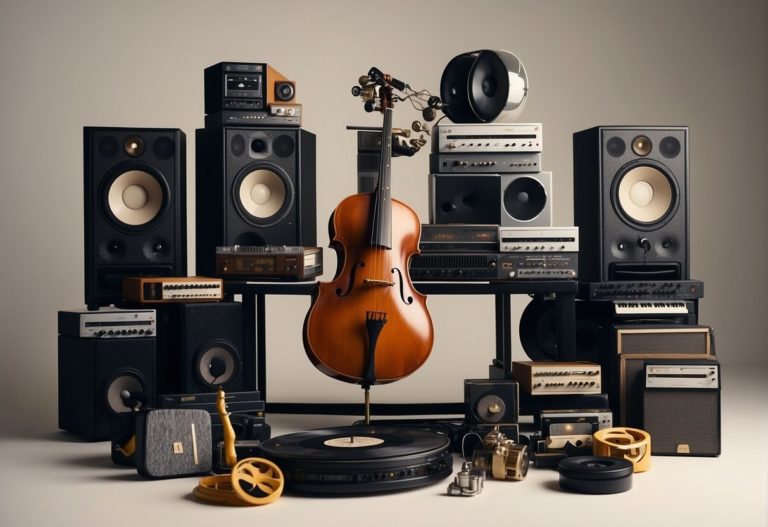What is the Most Popular Music Genre Today?

Music is a universal language that has the power to transcend cultural and social barriers. It is an art form that has been enjoyed by people for centuries and continues to evolve with time. With so many different music genres available today, it can be challenging to determine which one is the most popular. However, by examining various factors such as music sales, streaming statistics, and cultural influence, we can gain insight into what music genres are currently the most popular.
Over the years, music has evolved and diversified into many different genres. From classical music to rock, hip-hop, and electronic dance music, each genre has its unique characteristics and fan base. The popularity of music genres has also been influenced by various factors such as technological advancements, cultural and social changes, and the rise of streaming services. With so many music genres available today, it can be challenging to determine which one is the most popular. However, by examining various factors such as music sales, streaming statistics, and cultural influence, we can gain insight into what music genres are currently the most popular.
Key Takeaways
- Music is a universal language that has the power to transcend cultural and social barriers.
- The popularity of music genres has been influenced by various factors such as technological advancements, cultural and social changes, and the rise of streaming services.
- By examining various factors such as music sales, streaming statistics, and cultural influence, we can gain insight into what music genres are currently the most popular.
Evolution of Music Genres
Music is an art form that has evolved over time. It has been influenced by various factors such as cultural, social, technological, and political changes. The evolution of music genres has been a gradual process that has taken place over centuries. In this section, we will take a look at the evolution of music genres from the 20th century to the present day.
20th Century Origins
The 20th century saw the emergence of various music genres such as pop, rock, jazz, hip-hop, country, and classical music. Pop music became popular in the 1950s and 1960s, with artists such as Elvis Presley and The Beatles dominating the charts. Rock music emerged in the 1960s, with bands such as Led Zeppelin, The Rolling Stones, and Pink Floyd becoming popular.
Jazz music has its roots in African American communities in the United States. It emerged in the early 20th century and became popular in the 1920s. Hip-hop emerged in the 1970s in African American and Latin American communities in New York City. It has since become a global phenomenon.
Country music has its roots in the folk music of the Southern United States. It became popular in the 1920s and 1930s and has since evolved into various sub-genres such as country pop, country rock, and alt-country.
Classical music has a long history dating back to the medieval period. It has evolved over time and has been influenced by various cultural and social changes.
Digital Age Developments
The digital age has brought about significant changes in the music industry. The rise of on-demand streaming services such as Spotify and Apple Music has significantly influenced the consumption of music genres. According to PrimeSound.org, the most popular music genres globally are pop, rock, hip-hop, R&B/Soul, and Latin music.
The growth of EDM (Electronic Dance Music) has been significant in recent years. It has become a popular genre, especially among young people. EDM has various sub-genres such as house, techno, and trance.
In conclusion, the evolution of music genres has been a gradual process that has taken place over centuries. The 20th century saw the emergence of various music genres such as pop, rock, jazz, hip-hop, country, and classical music. The digital age has brought about significant changes in the music industry, with on-demand streaming services such as Spotify and Apple Music significantly influencing the consumption of music genres.
Current Popular Music Genres

The music industry is constantly evolving, with new genres emerging and existing ones evolving. However, some genres have remained popular over the years, attracting a steady fanbase and maintaining their dominance. Here are some of the most popular music genres in 2024:
Pop Music Dominance
Pop music has been one of the most popular music genres for decades, and it continues to dominate the charts in 2024. Its catchy melodies, upbeat rhythms, and relatable lyrics appeal to a wide audience, making it a staple of mainstream music. According to PrimeSound.org, pop music accounts for 24.5% of all music streamed on Spotify, making it the most streamed genre on the platform.
Hip-Hop and Rap Expansion
Hip-hop and rap have been steadily growing in popularity over the years, and they continue to expand their reach in 2024. These genres are known for their unique beats, clever wordplay, and social commentary, making them popular among younger audiences. According to HeadphonesAddict.com, hip-hop and rap account for 22.2% of all music streamed on Spotify, making them the second most streamed genre on the platform.
Rock’s Persistent Appeal
Rock music has been around for decades, and it remains a popular genre in 2024. Its electric guitars, driving beats, and rebellious spirit have attracted generations of fans. Despite the rise of other genres, rock music continues to appeal to a wide audience, with classic rock and roll bands still selling out stadiums. According to PrimeSound.org, rock music accounts for 14.3% of all music streamed on Spotify.
Electronic Dance Music (EDM) Surge
Electronic dance music (EDM) has been growing in popularity over the years, and it continues to surge in 2024. Its pulsing beats, energetic rhythms, and immersive experiences make it popular among younger audiences. According to AudioCaptain.com, EDM is the third most popular genre in the world, with a global market share of 7.5%.
Country Music’s Steady Fanbase
Country music has a loyal fanbase that has remained steady over the years. Its storytelling lyrics, twangy guitars, and down-to-earth themes appeal to a wide audience, especially in rural areas. According to PrimeSound.org, country music accounts for 7.2% of all music streamed on Spotify.
R&B and Soul Resurgence
R&B and soul have been making a comeback in recent years, with new artists putting their own spin on classic sounds. These genres are known for their smooth vocals, emotional lyrics, and soulful melodies, making them popular among a diverse audience. According to AudioCaptain.com, R&B and soul are the fifth most popular genres in the world, with a global market share of 6.9%.
In conclusion, these are some of the most popular music genres in 2024, attracting a diverse fanbase and dominating the charts. While new genres may emerge and existing ones may evolve, these genres have proven their popularity and staying power over the years.
Influence of Technology and Media

Streaming Platforms
The rise of streaming platforms such as Spotify, YouTube, and Amazon Music has had a significant impact on the music industry. According to a report by Nielsen Music, audio streams in the US reached a record high of 611 billion in 2023, up from 560 billion in 2022. This shift towards streaming has led to a decline in physical sales, with CDs and vinyl sales dropping by 15.5% and 11.9%, respectively, in 2023.
Streaming platforms have also changed the way music is consumed, with users having access to millions of songs at their fingertips. This has made it easier for listeners to discover new artists and genres, and has contributed to the popularity of certain genres such as hip-hop and pop.
Social Media Impact
Social media has also played a significant role in the popularity of certain music genres. Platforms such as Instagram, TikTok, and Twitter have made it easier for artists to connect with their fans and promote their music. This has led to the rise of viral hits and the increased popularity of certain genres such as Latin music.
Sales and Chart Metrics
Sales and chart metrics such as the Billboard Hot 100 and album sales have traditionally been used to determine the popularity of music genres. However, with the rise of streaming platforms, these metrics have become less reliable. In 2023, the Billboard Hot 100 began incorporating audio streams and digital sales into its chart algorithm, which has led to more accurate representation of the most popular music genres.
In conclusion, the influence of technology and media has had a significant impact on the popularity of music genres. The rise of streaming platforms and social media has changed the way music is consumed and has contributed to the popularity of certain genres such as hip-hop and pop. Sales and chart metrics have also evolved to incorporate streaming data, providing a more accurate representation of the most popular music genres.
Cultural and Social Factors
Demographic Preferences
Music preference is often shaped by demographic factors such as age, race, and ethnicity. For instance, younger audiences tend to prefer genres such as hip-hop and electronic dance music (EDM), while older audiences may prefer jazz, classical, and country music. African American and Latino audiences have historically played a significant role in shaping music trends in the United States, particularly in genres such as hip-hop and R&B/soul.
Cultural Movements and Music
Music has always been intertwined with cultural movements, and popular music is no exception. For example, the rise of hip-hop in the 1980s and 1990s was closely tied to the emergence of African American and Latino cultures in urban areas. Similarly, the popularity of world music and Bollywood soundtracks in recent years reflects growing interest in global cultures and the increasing diversity of Western societies.
Political and Economic Influences
Music is also influenced by political and economic factors. For example, the rise of hip-hop in the 1980s and 1990s was closely linked to economic and social issues facing African American and Latino communities, such as poverty, unemployment, and police brutality. Similarly, the emergence of punk rock in the 1970s was a response to the political and economic upheavals of the time, such as the Vietnam War, the Watergate scandal, and the oil crisis.
In conclusion, cultural and social factors play a crucial role in shaping music preferences and trends. Demographic factors such as age, race, and ethnicity, as well as cultural movements and political and economic influences, all contribute to the popularity of different genres and artists.
Music Genre Crossovers and Fusions
Music genres have evolved over time, and as a result, many artists have experimented with blending different genres to create unique sounds. The fusion of different genres has resulted in the creation of new sub-genres, which have become increasingly popular over the years. In this section, we will discuss the impact of music genre crossovers and fusions on the music industry.
Genre Blending
Genre blending refers to the process of combining different genres to create a new sound. This technique has been used by many artists across different genres, including pop, rock, hip-hop, EDM, Latin, country, jazz, reggae, funk, psychedelic, acid, progressive rock, soft rock, arena rock, heavy metal, punk rock, grunge, bluegrass, and easy listening.
One of the most famous examples of genre blending is the fusion of rock and rap, which resulted in the creation of a new sub-genre called rap rock. This sub-genre was popularized by bands such as Rage Against the Machine, Limp Bizkit, and Linkin Park. Another example is the fusion of country and hip-hop, which has resulted in the creation of a new sub-genre called country rap. This sub-genre has been popularized by artists such as Lil Nas X and Blanco Brown.
Sub-genre Innovation
Sub-genre innovation refers to the creation of new sub-genres by blending different genres. This technique has been used by many artists across different genres, including pop, rock, hip-hop, EDM, Latin, country, jazz, reggae, funk, psychedelic, acid, progressive rock, soft rock, arena rock, heavy metal, punk rock, grunge, bluegrass, and easy listening.
One of the most famous examples of sub-genre innovation is the creation of electronic dance music (EDM) by blending different genres such as techno, house, and trance. This sub-genre has become increasingly popular over the years and has been popularized by artists such as Calvin Harris, David Guetta, and Tiësto. Another example is the creation of reggae rock, which is a fusion of reggae and rock. This sub-genre has been popularized by bands such as Sublime and 311.
In conclusion, genre blending and sub-genre innovation have had a significant impact on the music industry. These techniques have resulted in the creation of new sounds and sub-genres, which have become increasingly popular over the years.
Notable Artists and Albums
Iconic Musicians
When it comes to popular music genres, there are several iconic musicians who have made an impact on the industry. Johnny Cash, often referred to as the “Man in Black,” is a legendary country music singer who has sold over 90 million records worldwide. His deep, distinctive voice and storytelling lyrics have made him a beloved figure in country music.
Eminem, known for his controversial lyrics and rapid-fire delivery, is a highly influential figure in the world of hip-hop. He has sold over 150 million records worldwide and has won numerous awards, including 15 Grammy Awards. His albums, such as “The Slim Shady LP” and “The Marshall Mathers LP,” have become classics in the genre.
Taylor Swift, a pop and country music singer, has become one of the best-selling music artists of all time. She has won numerous awards, including 10 Grammy Awards, and has sold over 50 million albums worldwide. Her albums, such as “1989” and “Red,” have topped the charts and have become staples in the pop music genre.
Impactful Albums
Throughout the years, there have been several albums that have made a significant impact on the music industry. Dolly Parton’s “Coat of Many Colors” is a classic country album that tells the story of Parton’s upbringing in rural Tennessee. The album, released in 1971, has become a beloved classic in the country music genre.
Garth Brooks’ “No Fences” is another classic country album that has made a lasting impact on the industry. The album, released in 1990, has sold over 17 million copies in the United States alone and features hits such as “Friends in Low Places” and “The Thunder Rolls.”
In the world of pop music, Michael Jackson’s “Thriller” is often cited as one of the most impactful albums of all time. The album, released in 1982, has sold over 66 million copies worldwide and features hits such as “Beat It” and “Billie Jean.”
In the world of rock music, Pink Floyd’s “The Wall” is a classic album that has become a staple in the genre. The album, released in 1979, tells the story of a rock star’s descent into madness and features hits such as “Another Brick in the Wall” and “Comfortably Numb.”
In the world of EDM (Electronic Dance Music), Daft Punk’s “Random Access Memories” is a highly influential album that has made a significant impact on the genre. The album, released in 2013, features collaborations with artists such as Pharrell Williams and Nile Rodgers and has won numerous awards, including Album of the Year at the 2014 Grammy Awards.
Future Trends and Predictions
Emerging Genres
As the music industry continues to grow and evolve, new genres are emerging and gaining popularity. Some of the emerging genres to watch out for in the future include:
- Hyperpop: This genre combines elements of pop, electronic dance music (EDM), and hip-hop to create a high-energy, hyperactive sound. It has gained popularity on platforms like TikTok and is expected to continue to grow in popularity.
- K-Pop: Korean pop music has been gaining popularity globally for several years now, and this trend is expected to continue. K-Pop is known for its catchy melodies, synchronized dance routines, and elaborate music videos.
- Afrobeats: This genre, which originated in West Africa, has been gaining popularity globally in recent years. It combines elements of African rhythms, hip-hop, and pop music to create a unique sound.
Industry Forecasting
Industry experts predict that streaming will continue to dominate the music industry in the future. Streaming platforms like Spotify, Apple Music, and Amazon Music have revolutionized the way people consume music. They offer users access to millions of songs at their fingertips, and this convenience has led to a surge in demand for streaming services.
In terms of music genres, experts predict that hip-hop and rap will continue to be the most popular genres in the future. These genres have dominated the charts for several years now and show no signs of slowing down. However, other genres like pop, rock, and country are also expected to continue to have a strong presence in the industry.
As for formats and presentations, virtual concerts and live streaming are expected to become more popular in the future. The COVID-19 pandemic has accelerated the adoption of these formats, and they are likely to become a permanent part of the music industry.
Overall, the music industry is expected to continue to grow in the future, with new genres emerging, streaming dominating, and virtual formats becoming more popular.
Conclusion
After analyzing various sources, it is clear that the most popular music genre worldwide is pop music. According to the latest Music Consumer Insight Report by IFPI, pop music accounts for 64% of global music consumption.
Other popular music genres include rock, hip-hop/rap, electronic dance music (EDM), country, jazz, classical, R&B/soul, and indie/alternative. However, their popularity varies depending on the region, culture, and demographics of the listeners.
For instance, rock music has a massive following in Europe and North America, while hip-hop/rap dominates the charts in the United States. Country music is more popular in the rural areas of the United States, Canada, and Australia, while classical music has a strong following among the older population and music enthusiasts.
It is worth noting that music genre popularity is not static, and it changes over time. For example, the popularity of disco music peaked in the 1970s and declined in the 1980s, while electronic dance music has gained massive popularity in the 21st century.
In conclusion, pop music is the most popular music genre worldwide, but the popularity of other genres varies depending on the region, culture, and demographics of the listeners.
Frequently Asked Questions
Which music genre currently dominates global charts?
As of 2023, pop music continues to dominate the global charts. According to Statista, pop music is the most popular music genre in the world. It accounted for 64% of the music consumption worldwide. However, the popularity of other genres such as hip-hop, rock, and R&B is also increasing.
What are the top three music genres in the United States?
According to PrimeSound.org, the top three music genres in the United States are Hip-hop/Rap, Pop, and Rock. These three genres have been consistently popular in the US for many years.
Has rap music become the leading music genre today?
Yes, rap music has become the leading music genre in the United States, surpassing rock as the most popular genre among music fans in 2019. According to Gitnux.org, hip-hop accounted for 24.7% of the music consumed in the US in 2019, making it the most popular genre among music fans.
What are the main types of music categories recognized worldwide?
The main types of music categories recognized worldwide are Pop, Rock, Hip-hop/Rap, Country, Jazz, Classical, R&B/Soul, Indie/Alternative, and Latin. These categories are recognized by the International Federation of the Phonographic Industry (IFPI) and are based on music consumption and sales worldwide.
Which music genre has consistently been popular through the years?
Pop music has consistently been popular through the years. It has been the most dominant music genre for many years and continues to be so. However, other genres such as rock and hip-hop have also gained popularity over the years.
What are the prevailing music genre trends as of 2023?
As of 2023, the prevailing music genre trends are the increasing popularity of hip-hop/rap and the fusion of different music genres. Many artists are now experimenting with different music genres to create unique sounds and styles. Additionally, electronic dance music (EDM) is also gaining popularity, especially among the younger generation.





